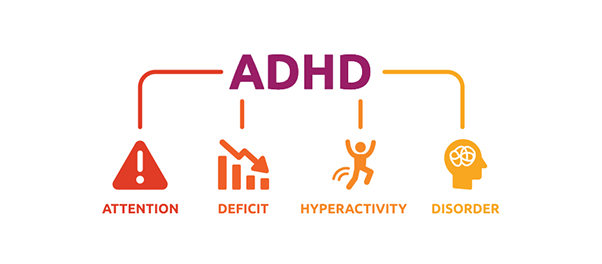What is ADHD?
ADHD stands for attention-deficit/hyperactivity disorder. Attention-deficit/hyperactivity disorder affects cognitive functioning skills and limits the ability of an individual to filter out unimportant information, focus, organize, prioritize, delay gratification, think before they act, and perform executive functions. ADHD affects children and lasts into adulthood.
Signs of ADHD in Children
Since ADHD diagnosis falls on a spectrum, there are two distinctions between symptoms. The symptoms are categorized based on inattentiveness and hyperactivity. To receive a clinical diagnosis of ADHD, the DSM-V covers five subsets of symptoms. The first two criteria of symptoms include “a persistent pattern of inattention and/or hyperactivity-impulsivity that is more frequently displayed and severe than typically observed” in comparison to their peers of the same developmental age as well as symptoms that “cause impairment…present before age 7 years.
There are three subtypes encompassing the spectrum of attention-deficit/hyperactivity disorder:
- Predominantly inattentive
- Predominantly hyperactive
- Combined (inattentive and hyperactive)
Dr. Barbara Fisher Ph.D., a neuropsychologist and author of What You Think ADD/ADHD Is, It Isn’t, lists the signs of ADHD as follows:
Symptoms of Inattention:
- Not paying attention to detail or making careless mistakes
- Messy work, poorly sustained attention, difficulty completing tasks
- Appear as if they are not listening
- Shifts activity from one to another, lacks follow-through
- Tasks requiring sustained mental effort avoided due to inattention
- Disorganized work habits, necessary items lost or scattered
- Easily distracted by irrelevant stimuli
- Forgetfulness in daily activities
- Inattention occurring during social conversation
Symptoms of Hyperactivity:
- Fidgeting or squirming in the seat
- Not remaining seated
- Excessive running or climbing when inappropriate for the environment
- Appearing to be on the go
- Talking excessively
Symptoms of Impulsivity:
- Impatience, blurting out answers, difficult delaying response
- Frequently interrupting and intruding on others
- Initiating conversations at inappropriate times
- Talking excessively
- Fidgety or squirming in the seat
- Not remaining seated
The following are age-specific symptoms at varying developmental stages:
- Toddlers and Preschoolers: Constantly on the go, into everything, darting back and forth.
- School-age children: Less intensity, tend to get up frequently, squirm in the seat, fidget with objects.
- Adolescents and adults: Restlessness, difficulty engaging in sedentary activities.
How to Help a Child with ADHD
To help a child with ADHD, remember to practice patience and understand your child is neurodivergent. (Neurodivergent is a term to describe individuals with varying cognitive functioning skills). Children with ADHD think and behave differently, and different doesn’t mean bad or wrong. ADHD falls on a spectrum, so not every child with ADHD will behave with the same mannerisms and functioning skills.
ADHD symptoms also present differently in females than males, so take your child to a pediatrician for a referral or expert diagnosis. Much of past research on ADHD centered around boys, so the condition has been referred to as a “boy’s disorder.” Girls are less likely to be diagnosed and receive treatment because their symptoms do not attract much attention until they are older. Some of these symptoms include anxiousness, distress, spaciness, and depression.
Benefits of ADHD
Behaviors with links to ADHD are often stigmatized. With the proper support, an ADHD diagnosis does not limit a child’s capabilities to excel in social and academic settings. There are ways in which neurodivergence positively contributes to the way children with ADHD experience life.
In a qualitative study on “The Positive Aspects of ADHD” by Sedgwick, Merwood, and Asherson, they list six core themes found in their study interviews. Courage, humanity, resilience, and transcendence align with core concepts of positive psychology research.
The following list outlines self-reported positive aspects:
- Cognitive dynamism: Cognitive dynamism refers to the constant state of mental activity individuals with ADHD experience.
- Courage: Courage includes concepts like equity, social justice, and human rights.
- Energy: Participants report an abundance of energy as a positive aspect.
- Humanity: Humanity covers social intelligence, humor, self-acceptance, and recognition of feelings.
- Resilience: Resilience defines coping responses to stress.
- Transcendence: Transcendence described the musical experience of one participant with a defining subtheme, appreciation of beauty and excellence.
Another emerging trait in reference to ADHD, hyperfocus appears in recent research as a concept where adults with ADHD “report long episodes of long-lasting, highly focused attention” contrary to symptoms of inattention according to “Living “in the zone”: Hyperfocus in Adult ADHD” by Sedgwick, Merwood, and Asherson. The theory is adults with ADHD are able to focus for lengthy periods of time on specific interests, although ADHD research on this topic is new.
Myths of ADHD
In ADHD: What Every Parent Needs to Know by the American Academy of Pediatrics, Dr. Mark Wolraich and Dr. Joseph Hagan Jr. outline common myths surrounding children with ADHD.
- Myth #1: ADHD only shows up in older children.
ADHD can occur as early as preschool age. Doctors are able to diagnose two to five-year-olds. - Myth #2: Children with ADHD are lazy or unmotivated.
Children with ADHD function differently and require alternative treatment to accommodate their neurodivergence. - Myth #3: ADHD goes away.
Children diagnosed with ADHD do not outgrow the medical condition. There is no treatment proven to eliminate symptoms altogether, and adults experience ADHD symptoms. - Myth #4: Bad parenting or schooling causes ADHD.
ADHD is not caused by a lack of discipline in parenting or additional factors like teachers and the school environment. - Myth #5: Children who focus on video games can’t have ADHD.
Children with ADHD are able to focus on highly engaging media like video games, music, or television because of the stimulation.
ADHD Therapies
Treatment plans for attention-deficit/hyperactivity disorder consist of medication in combination with parent behavior management training.
Medication
In younger children, especially before age six, parents are recommended to look into behavioral training before the use of medications. Stimulants such as Ritalin, Dexedrine, or Adderall are common in children with ADHD.
Young children between the ages of four and six respond better to short-acting stimulants than long-acting for older children in school for more extended periods. There is a class of non-stimulant drugs available as well, although they do not work as quickly as stimulants. Side effects may occur like loss of appetite, so be sure to discuss these symptoms with a medical provider.
Behavior Training
Parent behavior management training aims to encourage appropriate behavior in the child and inhibit negative impacts on the child’s school and social life. Parents are encouraged to focus on organizational, behavioral, and peer interventions.
From the American Academy of Pediatrics, management tips to help a child with ADHD include:
- Keeping your child on a daily schedule
- Cutting down on distractions
- Developing a homework plan with your child
- Organizing your house
- Using charts and checklists
- Limiting choices
- Setting small, reachable goals
- Keeping the plan child-centered
- Ensuring the child is well-rested
Children with attention-deficit/hyperactivity disorder need additional structure to guide their behaviors because of their attention and focus habits.
























